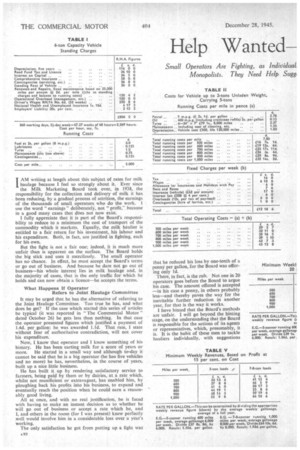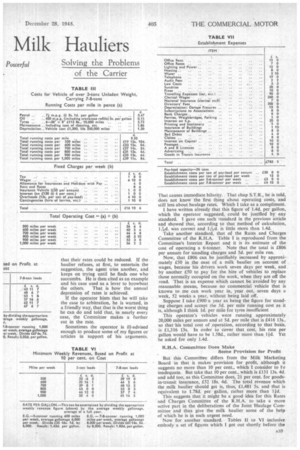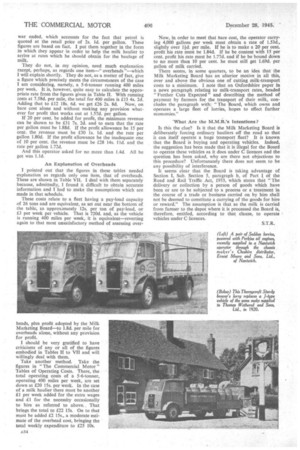that he reduced his loss by one-tenth of a penny
Page 34

Page 35

Page 36

If you've noticed an error in this article please click here to report it so we can fix it.
per gallon, for the Board was offering only There, in fact, is the rub. Not one in 20 operators goes before the Board to argue his case. The amount offered is accepted -in his case a penny, in others probably less-and thereby paves the way for the inevitable further reduction in another year, for that is the way it works.
I have hinted that the Board's methods are unfair. I will go beyond the hinting stage, on the understanding that the Board is responsible for the actions of its agents or representatives, which, presumably, it is. It is the habit of these men to tackle hauliers individually, • with suggestions
that their rates could be reduced. If the haulier refuses, at first, to entertain the suggestion, the agent tries another, and keeps on trying until he finds one who succumbs. He is then cited as an example and his case used as a lever to browbeat the others. That is how the annual depression of rates is achieved.
If the operator hints that he will take the case to arbitration, he is warned, in a friendly way, that that is the worst thing he can do and told that, in nearly every case, the Committee makes a further cut in the rate.
Sometimes the operator is ill-advised enough to produce some of my figures or articles in support of his arguments. That causes immediate hilarity. That chap S.T.R., he is told, does not know the first thing about operating costs, and still less about haulage rates. Which I take as a compliment.
I have written already that this figure of lAd. per gallon, which the operator suggested, could be justified by any standard, 1 gave one such standard in the previous article and showed that, according to that method of calculation, 1 ,70.1. was correct and 1A-d. is little more than 1.4d.
Take another standard, that of the Rates and Charges Committee of the R.1-1.A. Table I is reproduced from the Committee's Interim Report and it is its estimate of the cost. of operating a 6-tonner. Note that the total is £806 per annum for standing charges and 5d. per mile run.
Now, that £806 can be justifiably increased by approximately £50 in the case of a milk haulier on account of wages, because his drivers work seven days per week, and by another £50 to pay for the hire of vehicles to replace those normally occupied on the work, when they are off the road. That is an expense which cannot be avoided by any reasonable means, because no commercial vehicle that is known to ale can work year in, year out, seven days a week, 52 weeks a year, without being laid off.
Suppose I take £900 a year as being the figure for standing charges and accept the 5d. per mile running cost as it is, although I think Id. per mile for tyres insufficient This operator's vehicles were running approximately 20,000 miles per annum and at 5d. per mile that is £416 I3s., so that his total cost of .operation, according to that basis, is £1,316 13s. In order to cover that cost, his rate per gallon would have to be 1.58d., rather more than 10. Yet he asked for only 1.4d.
R.H.A. Committee Does Make
Some Provision for Profit
But this Committee differs from the Milk Marketing Board in that it makes provision for profit, although it suggests no more than 10 per cent., which I consider to he inadequate. But take that 10 per cent., which is £131 13s. 411, and add too, as this Committee does, 2i per cent. for goodsin-transit insurance, £32 18s. 4d. The total revenue which the milk haulier should get is, thus, £1,481 5s. and that is equivalent to 1.78d per gallon, rather more than IN. This suggests that it might be a good idea for this Rates and Charges Committee of the R.H.A. to take a more active part in the deliberations of the Joint Haulage Committee and thus give the milk haulier some of the help of which he is in such urgent need.
Now for another standard. Tables II to VI inclusive embody a set of figures which I got out shortly before the war ended, which accounts for the fact that petrol is quoted at the retail price of 2s. Id. per gallon. These figures are based on fact. I put them together in the form in which they appear in order to help the milk haulier to arrive at rates which he should obtain for the haulage of milk.
They do not, in my opinion, need much explanation except, perhaps, as regards one item—" overheads "—which I will explain shortly. They do not, as a matter of fact, give a figure which precisely meets the circumstances of the case 1 am considering, namely, a 5-6-tonner running 400 miles per week. It is, however, quite easy to calculate the appropriate rate from the figures given in Table II. With running eosts at 7.58d. per mile, the total for 400 miles is £13 4s. 2d. Adding that to £12 18s. 6d. we get £26 2s. 8d. Now, on bare cost alone and without making any provision whatever for profit that works out at 1.57d. per gallon. If 20 per cent, be added for profit, the minimum revenue can be shown to be £31 7s. 2d. and to earn that the rate per gallon must be 1.88d. If the profit allowance be 15 per cent, the revenue must be £30 ls. id. and the rate per gallon 1.80d. If the profit allowance be the inadequate one of 10 per cent. the revenue must be £28 14s. 11d, and the rate per gallon 1.72d.
And this operator asked for no more than 1.4d. All he got was 1.1d.
An Explanation of Overheads I pointed out that the figures in these tables needed explanation as regards only one item, that of overheads. These are shown in Table VII. I deal with them separately because, admittedly, I found it difficult to obtain accurate information and I had to make the assumptions which are made in that schedule.
These costs relate to a fleet having a pay-load capacity of 26 tons and are equivalent, as set out near the bottom of the table, to approximately I2s. per ton of pay-load, or £3 per week per vehicle. That is 720d. and, as the vehicle is running 400 miles per week, it is equivalent—reverting again to that most unsatisfactory method of assessing over heads, plus profit adopted by the Milk Marketing Board—to 1.8d. per mile for overheads alone, without any provision for profit.
I should be very gratified to have criticisms of any or all of the figures embodied in Tables II to VII and will willingly deal with them.
Take another method. Take the figures in "The Commercial Motor" Tables of Operating Costs. There, the total operating costs of a 5-6-tonner, operating 400 miles per week, are set down at £20 15s. per week. In the case of a milk haulier there must be another £1 per week added for the extra wages and .£1 for the necessity occasionally to hire as referred to above., That brings the total to £22 15s. On to that must be added £2 I5s., a moderate estimate of the overhead cost, bringing the total weekly expenditure to £25 10s. Now, in order to meet that bare cost, the operator carrying 4,000 gallons per week must obtain a rate of 1.53d., slightly over lid. per mile. If he is to make a 20 per cent. profit his rate must be 1.84d. If he be content with 15 per cent, profit his rate must be 1.77d. and if he be bound down to no more than 10 per cent. he must still get 1.69d. per gallon of milk carried.
There seems, in some quarters, to be an idea that the Milk Marketing Board has an ulterior motive in all this, over and above the obvious one of cutting milk-transport costs to a minimum. I note that an Oxfordshire paper in a news paragraph relating to milk-transport rates, headed "Further Cuts Expected" and describing the method of payment by farmers for the transport of their milk, concludes the paragraph with: "The Board, which owns and operates a large fleet of lorries, hopes to effect further economies."
'What Are the M.M.S.'s Intentions ?
Is this the clue? Is it that the Milk Marketing Board is deliberately forcing ordinary hauliers off the road so that it can itself operate a huge transport fleet? It is known that the Board is buying and operating vehicles. Indeed, the suggestion has been made that it is illegal for the Board to operate these vehicles as it does under C licences and the question has been asked, why are there not objections to this procedure? Unfortunately there does not seem to be any possibility of interference. It seems clear that the Board is taking advantage of Section I, Sub. Section 5, paragraph b, of Part I of the Road and Rail Traffic Act, 1933, which states that "The delivery or collection by a person of goods which have been or are to be subjected to a process or a treatment in the course of a trade or business carried on by him shall not be deemed to constitute a carrying of the goods for hire or reward." The assumption is that as the milk is carried from farmer to the depot where it is processed the Board is, therefore, entitled, according to that clause, to operate vehicles under C licences.
S.T.R.




































































